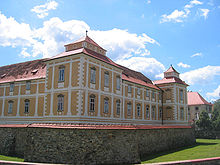History
The predecessor of the current Slovenska Bistrica castle is first mentioned in 1265, when emperor Rudolf gave it and the adjoining town in fief to count (from 1286 duke of Carinthia) Meinhard of Gorizia. In 1313, it passed to the Habsburgs, who leased the castle and town to the House of Walsee, an old Austrian noble family. After 1368, the lordship was obtained by the Counts of Celje; after their extinction in 1456 it reverted to the ducal lands. In 1587, the town and castle were bought by Hans Vetter; in 1717 the castle only was sold to the Counts of Attems, who retained until the end of World War II, when it was nationalized.
During the Attems tenure, the castle was the home of the painter and historian Countess Maria von Attems-Petzenstein (born 1893).
Architecture
The mansion is located on the northwest side of the mediaeval old town of Slovenska Bistrica. Rebuilt into a renaissance mansion in the 17th century, the foundations of the current building adjoin one of the defensive towers of its fortified predecessor.
The layout is trapezoidal, with a turret at each corner and an arcaded inner courtyard. The entire building is surrounded with a moat, now dry. The surrounding estate was planted with rare trees, now neglected, and a hornbeam tree row. The Attems decorated the interior in the early 18th century; the castle features a painted staircase, a chapel dedicated to the Virgin Mary, and a richly appointed great hall.

Slovenska Bistrica is a town south of Maribor in eastern Slovenia. It is the seat of the Municipality of Slovenska Bistrica, one of the largest municipalities in Slovenia. The area is part of the traditional region of Styria. The town is included in the Drava Statistical Region.

Brdo Castle near Kranj, usually simply Brdo Castle, is an estate and a mansion in the Slovenian region of Upper Carniola west of the village of Predoslje, City Municipality of Kranj, northwest of Ljubljana. It is the Slovenian government's main venue for diplomatic meetings and other government-sponsored events.

Ilirska Bistrica is a town in the Inner Carniola region of southwestern Slovenia. It is the administrative seat of the Municipality of Ilirska Bistrica.
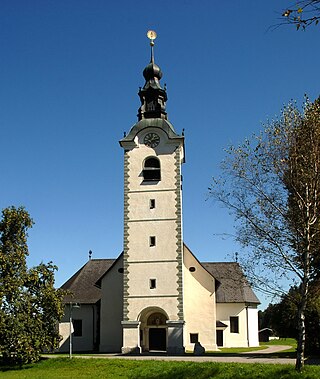
Feistritz im Rosental, often referred to as simply Feistritz, is a market town in the district of Klagenfurt-Land in the Austrian state of Carinthia.

Brežice Castle is a 16th-century castle in the town of Brežice, in southeastern Slovenia, at the street address Cesta prvih borcev 1.

Tivoli Castle, originally called Podturn Manor, is a mansion in Ljubljana, the capital of Slovenia.
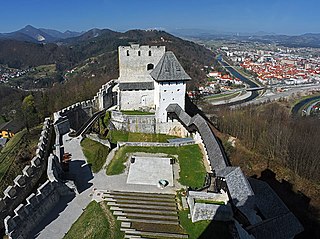
Celje Castle, also known as Celje Upper Castle or Old Castle, is a castle ruin in Celje, Slovenia, formerly the seat of the Counts of Celje. It stands on three hills to the southeast of Celje, where the river Savinja meanders into the Laško valley. Today, the castle is in the process of being restored. It was once the largest fortification on Slovenian territory.

Strmol Castle is a castle located at the foot of Dvorjanski hrib near the villages of Češnjevek, Grad and Dvorje, in the Municipality of Cerklje na Gorenjskem, Slovenia. Named after its builders, the Strmol family, it is notable as one of the few castles in Slovenia to retain a Slovene name throughout its history. It is currently a guesthouse and conference site for the government of the Republic of Slovenia.
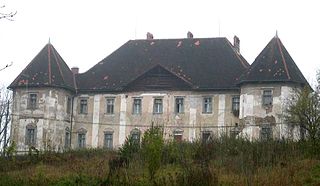
Bokalce Castle is a castle or mansion in Ljubljana, the capital of Slovenia. It stands at 312m above sea level.
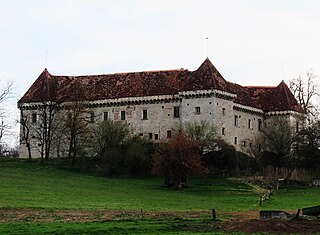
Krumperk Castle is a castle located in Gorjuša near the town of Domžale in central Slovenia.

Olimje Castle is a 16th-century castle located in the settlement of Olimje, part of the Municipality of Podčetrtek in eastern Slovenia. It is currently a Franciscan monastery.
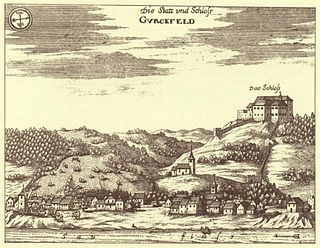
Krško Castle is a 12th-century castle ruin to the right of the Sava above the old center of the town of Krško, southeastern Slovenia. It stands in the territory of the settlement of Cesta. The castle and town are both named after the nearby Krka River.

Ig Castle, also Sonnegg Castle or Zonek Castle, stands on Pungart Hill above the settlement of Ig, on the southern outskirts of Ljubljana, the capital of Slovenia.

Vipava Castle is a castle ruin above the town of Vipava in the Municipality of Vipava in southwestern Slovenia.
Jakobski Dol Castle is a 17th-century castle located in the settlement of Spodnji Jakobski Dol, part of the municipality of Pesnica in northeastern Slovenia.
Nadgrad is a dispersed settlement in the Pohorje Hills in the Municipality of Slovenska Bistrica in northeastern Slovenia. The area is part of the traditional region of Styria. It is now included with the rest of the municipality in the Drava Statistical Region.
Podgrad na Pohorju is a small settlement in the Pohorje Hills in the Municipality of Slovenska Bistrica in northeastern Slovenia. The area is part of the traditional region of Styria. It is now included with the rest of the municipality in the Drava Statistical Region.
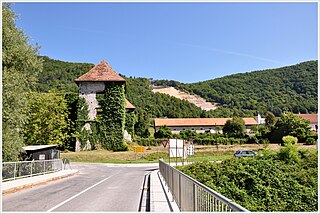
Soteska is a settlement on the left bank of the Krka River in the Municipality of Dolenjske Toplice in Slovenia. The area is part of the historical region of Lower Carniola. The municipality is now included in the Southeast Slovenia Statistical Region. Soteska includes the hamlet of Ključ southeast of the main settlement.
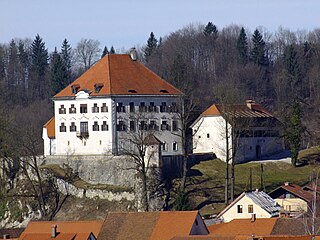
Zaprice Castle is a castle in Zaprice, now part of the town of Kamnik, Slovenia.
Frajštajn is a former settlement in the Municipality of Slovenska Bistrica in northeastern Slovenia. It is now part of the village of Spodnja Polskava. The area is part of the traditional region of Styria and is now included with the rest of the municipality in the Drava Statistical Region.
This page is based on this
Wikipedia article Text is available under the
CC BY-SA 4.0 license; additional terms may apply.
Images, videos and audio are available under their respective licenses.
